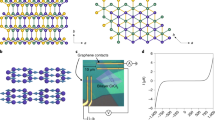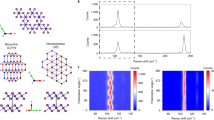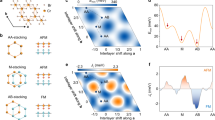Abstract
Long-range magnetic orders in atomically thin ferromagnetic CrI3 trigger new fascinating physics and application perspectives. The physical properties of two-dimensional (2D) ferromagnetism CrI3 are significantly influenced by interlayer spacing and stacking order, which are sensitive to the hydrostatic pressure and external environments. However, there remains debate on the stacking order at low temperature. Here, we study the interlayer coupling and stacking order of non-encapsulated 2–5 layer and bulk CrI3 at 10 K by Raman spectroscopy; demonstrate a rhombohedral stacking in both antiferromagnetic and ferromagnetic CrI3. The opposite helicity dependence of Ag and Eg modes arising from phonon symmetry further validates the rhombohedral stacking. An anomalous temperature-dependent behavior is observed due to spin-phonon coupling below 60 K. Our study provides insights into the interlayer coupling and stacking orders of 2D ferromagnetic materials.
摘要
二维体系中的长程铁磁序现象再次打破了Mermin-Wagner理论. 铁磁二维材料的铁磁性与层层堆叠的顺序、 结构、 层间距息息相关. 目前对铁磁二维材料CrI3在低温下的堆叠顺序和结构仍不确定, 且未见报道. 针对该科学问题, 本工作深入研究了2–5层及块体CrI3的拉曼特征, 详细研究了拉曼特征峰与层数、 偏振、 旋光和温度之间的依赖关系; 揭示了2–5层及块体CrI3在低温下(10 K)为菱方堆叠结构, 解决了领域内关于CrI3低温结构的争议, 填补了该领域的研究空白, 并发现了自旋声子耦合现象. 本工作开创了独特的磁光电原位传输测量系统, 从样品制备到表征完全与空气隔绝, 避免样品污染和损坏, 因此, 本工作更准确地表征出了CrI3最本征的结构特性.
Similar content being viewed by others
References
Huang B, Clark G, Navarro-Moratalla E, et al. Layer-dependent ferromagnetism in a van der Waals crystal down to the monolayer limit. Nature, 2017, 546: 270–273
Gong C, Li L, Li Z, et al. Discovery of intrinsic ferromagnetism in two-dimensional van der Waals crystals. Nature, 2017, 546: 265–269
Zhong D, Seyler KL, Linpeng X, et al. van der Waals engineering of ferromagnetic semiconductor heterostructures for spin and valleytronics. Sci Adv, 2017, 3: e1603113
Deng Y, Yu Y, Song Y, et al. Gate-tunable room-temperature ferromagnetism in two-dimensional Fe3GeTe2. Nature, 2018, 563: 94–99
Mounet N, Gibertini M, Schwaller P, et al. Two-dimensional materials from high-throughput computational exfoliation of experimentally known compounds. Nat Nanotech, 2018, 13: 246–252
Lee JU, Lee S, Ryoo JH, et al. Ising-type magnetic ordering in atomically thin FePS3. Nano Lett, 2016, 16: 7433–7438
Bonilla M, Kolekar S, Ma Y, et al. Strong room-temperature ferromagnetism in VSe2 monolayers on van der Waals substrates. Nat Nanotech, 2018, 13: 289–293
Song T, Cai X, Tu MWY, et al. Giant tunneling magnetoresistance in spin-filter van der Waals heterostructures. Science, 2018, 360: 1214–1218
Klein DR, MacNeill D, Lado JL, et al. Probing magnetism in 2D van der Waals crystalline insulators via electron tunneling. Science, 2018, 360: 1218–1222
Wang Z, Gutiérrez-Lezama I, Ubrig N, et al. Very large tunneling magnetoresistance in layered magnetic semiconductor CrI3. Nat Commun, 2018, 9: 2516
Huang B, Clark G, Klein DR, et al. Electrical control of 2D magnetism in bilayer CrI3. Nat Nanotech, 2018, 13: 544–548
Jiang S, Shan J, Mak KF. Electric-field switching of two-dimensional van der Waals magnets. Nat Mater, 2018, 17: 406–410
Jiang S, Li L, Wang Z, et al. Controlling magnetism in 2D CrI3 by electrostatic doping. Nat Nanotech, 2018, 13: 549–553
Wang Z, Zhang T, Ding M, et al. Electric-field control of magnetism in a few-layered van der Waals ferromagnetic semiconductor. Nat Nanotech, 2018, 13: 554–559
Li T, Jiang S, Sivadas N, et al. Pressure-controlled interlayer magnetism in atomically thin CrI3. Nat Mater, 2019, 81
Song T, Fei Z, Yankowitz M, et al. Switching 2D magnetic states via pressure tuning of layer stacking. Nat Mater, 2019, 546: doi: https://doi.org/10.1038/s41563-019-0505-2
McGuire MA, Dixit H, Cooper VR, et al. Coupling of crystal structure and magnetism in the layered, ferromagnetic insulator CrI3. Chem Mater, 2015, 27: 612–620
Djurdjić-Mijin S, Šolajić A, Pešić J, et al. Lattice dynamics and phase transition in CrI3 single crystals. Phys Rev B, 2018, 98: 104307
Sun Z, Yi Y, Song T, et al. Giant nonreciprocal second-harmonic generation from antiferromagnetic bilayer CrI3. Nature, 2019, 572: 497–501
Klein DR, MacNeill D, Song Q, et al. Enhancement of interlayer exchange in an ultrathin two-dimensional magnet. Nat Phys, 2019, 546
Sivadas N, Okamoto S, Xu X, et al. Stacking-dependent magnetism in bilayer CrI3. Nano Lett, 2018, 18: 7658–7664
Webster L, Liang L, Yan JA. Distinct spin-lattice and spin-phonon interactions in monolayer magnetic CrI3. Phys Chem Chem Phys, 2018, 20: 23546–23555
Sun L, Zheng J. Optical visualization of MoS2 grain boundaries by gold deposition. Sci China Mater, 2018, 61: 1154–1158
Wu S, Shi X, Liu Y, et al. The influence of two-dimensional organic adlayer thickness on the ultralow frequency Raman spectra of transition metal dichalcogenide nanosheets. Sci China Mater, 2019, 62: 181–193
Zhao W, Ghorannevis Z, Amara KK, et al. Lattice dynamics in mono- and few-layer sheets of WS2 and WSe2. Nanoscale, 2013, 5: 9677–9683
Zhang X, Qiao XF, Shi W, et al. Phonon and raman scattering of two-dimensional transition metal dichalcogenides from monolayer, multilayer to bulk material. Chem Soc Rev, 2015, 44: 2757–2785
Xiao Y, Zhou M, Liu J, et al. Phase engineering of two-dimensional transition metal dichalcogenides. Sci China Mater, 2019, 62: 759–775
Ren J, Teng C, Cai Z, et al. Controlled one step thinning and doping of two-dimensional transition metal dichalcogenides. Sci China Mater, 2019, 62: 1837–1845
Lu X, Luo X, Zhang J, et al. Lattice vibrations and Raman scattering in two-dimensional layered materials beyond graphene. Nano Res, 2016, 9: 3559–3597
Zhao Y, Luo X, Li H, et al. Interlayer breathing and shear modes in few-trilayer MoS2 and WSe2. Nano Lett, 2013, 13: 1007–1015
Loudon R. The Raman effect in crystals. Adv Phys, 1964, 13: 423–482
Baum A, Milosavljević A, Lazarević N, et al. Phonon anomalies in FeS. Phys Rev B, 2018, 97: 054306
Granado E, García A, Sanjurjo JA, et al. Magnetic ordering effects in the Raman spectra of La1−xMn1−xO3. Phys Rev B, 1999, 60: 11879–11882
Jin W, Kim HH, Ye Z, et al. Raman fingerprint of two terahertz spin wave branches in a two-dimensional honeycomb Ising ferromagnet. Nat Commun, 2018, 9: 5122
Yao X, Ma J, Lin Y, et al. Magnetoelectric coupling across the interface of multiferroic nanocomposites. Sci China Mater, 2015, 58: 143–155
Acknowledgements
We acknowledge the financial support from the National Natural Science Foundation of China (51602040 and 51872039), the Science and Technology Program of Sichuan (M112018JY0025) and the Scientific Research Foundation for New Teachers of UESTC (A03013023601007).
Author information
Authors and Affiliations
Contributions
Author contributions Peng B developed the concept, designed the experiment and prepared the manuscript. Cheng Y synthesized the CrI3 crystal. Deng B, Guo K, Liu Z, Gao C and Shi Z prepared the CrI3 samples and performed the Raman measurements. Bi L, Zhou P, Zhang L, Lu H and Zhang L contributed to mechanism of Raman scattering.
Corresponding authors
Ethics declarations
Conflict of interest The authors declare no competing financial interests.
Additional information
Bo Peng received his BSc (Honors) from Lanzhou University in 2005, and obtained his PhD degree from the Technical Institute of Physics and Chemistry, Chinese Academy of Sciences in 2010. He did his postdoctoral research in Singapore between 2010 and 2015. He is currently the Head of the Magneto-optical 2D Materials Group in the University of Electronic Science and Technology of China. His research is focused on the 2D ferromagnetic materials toward spintronics and valleytronics.
Kai Guo received his BSc from the University of Electronic Science and Technology of China in 2017. He focuses his research on the Raman studies of 2D ferromagnetic CrI3.
Rights and permissions
About this article
Cite this article
Guo, K., Deng, B., Liu, Z. et al. Layer dependence of stacking order in nonencapsulated few-layer CrI3. Sci. China Mater. 63, 413–420 (2020). https://doi.org/10.1007/s40843-019-1214-y
Received:
Accepted:
Published:
Issue Date:
DOI: https://doi.org/10.1007/s40843-019-1214-y




